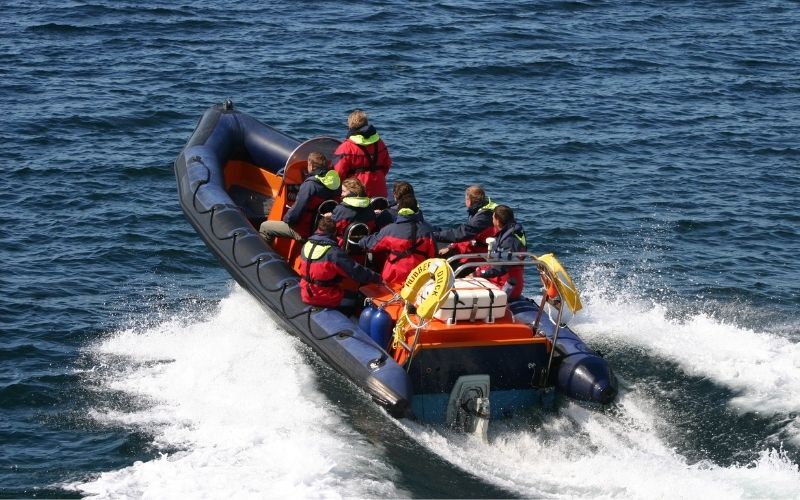If you have a rigid inflatable boat, or if you’re looking to buy one, you may have heard something about the different materials they may be made of. Specifically, you’ve probably heard a lot about PVC and Hypalon boats.
But what do these terms mean, exactly? What is PVC, what is Hypalon, and why does it matter in terms of the type of boat you have?
Which type of boat is better, and how do you distinguish between the two types of RIBs?
Great questions!
Read on to find out more.
Table of Contents
PVC vs. Hypalon
So your first question may be, why is the PVC vs. Hypalon discussion even important? Does it matter what material is used in the construction of your RIB? What are some of the basic differences between PVC and Hypalon, and why should you care?
Let’s take a closer look at each material, how it’s made, and some of the differences between the two.
PVC

PVC, or polyvinyl chloride, is one of the most widely used plastic products in the world. RIBs with PVC sponsors typically make use of a tough but flexible form of plastic.
PVC is cheap and easy to manufacture, as the seams can be easily welded together, and the raw materials used to make it are fairly inexpensive. This is a big reason why it’s so popular. With PVC, it’s possible to get a reasonably good-quality boat for a reasonable price.
It is important to keep remember that PVC has many different grades and qualities, and not all PVC boats are created equally. It’s a good idea to shop around, read customer reviews, and do your research before buying a PVC boat.
Hypalon
Hypalon is made of a rubber/neoprene product; specifically, it’s made from chlorosulfonated polyethylene rubber (CSM) reinforced with neoprene. Hypalon is a brand name produced by DuPont that was discontinued in 2009, but the CSM material is still used for making boats.
Hypalon is more lightweight and durable than PVC, and it generally holds up better against exposure to sunlight and chemicals. There are many different grades and qualities available, with the best ones coming from Europe or Japan.
Hypalon’s main drawback is that the seams can only be glued, not welded like PVC. This makes it more expensive to manufacture, which makes Hypalon boats generally more expensive than PVC boats.
Which is Better? PVC or Hypalon?
This, of course, is the million-dollar question: if you’re looking to buy a RIB boat, which is your best option: PVC or Hypalon?
The short answer is that Hypalon is the better material, but PVC has its perks as well. It all comes down to what you’re looking for in a boat.
For beginning boaters, those on a budget, or those who use their boat infrequently, PVC might be the best option because it’s inexpensive.
For those who want something highly durable, who use their boat frequently, or who regularly boat in extreme conditions, Hypalon is best because it is lighter and more durable than PVC.
Of course, if you’re looking for a Hypalon boat, you probably won’t be able to find a new one because the Hypalon brand name is no longer used.
So, when looking for a boat of the same material, you’ll need to look for the names CSM, CSPE, and CSM/CR, all of which stand for chlorosulfonated polyethylene rubber.
How Do I Know if My Boat is PVC or Hypalon?
So, say you already have a rigid inflatable boat, and you’re trying to figure out what it’s made of. Is there a way to tell the difference between PVC and Hypalon?
Several ways. Let’s take a look at some of these methods for decoding the material used in making your boat.
Brand Name

Though the Hypalon brand name is no longer in use, there are several boat brands known for using Hypalon to make their boats and other brands known for using PVC.
So, depending on your boat brand, you may be able to tell which material the boat is made out of.
Some common brands that have used Hypalon for their boats include:
- AB
- Avon
- Ballistic
- Gordon
- Novamarine
- Red Bay
- Scorpion
Some brands known for using PVC include:
- Arimar
- Brig
- Intex
- Quicksilver
- Sevylor
- Typhoon
Of course, this list is by no means exhaustive. For a more complete list, check out this article from PolyMarine.
Boat Size

If you’ve got a larger boat, especially one that’s relatively lightweight, chances are it’s made of Hypalon. Of course, it can be hard to determine this if you don’t have a PVC boat to compare against it.
Still, PVC is generally used more often for smaller recreational boats, while Hypalon is typically used for larger, more powerful inflatable boats.
Seams
Take a close look at the seams of your boat. As noted above, PVC seams are typically welded together, while Hypalon seams can only be glued.
It may depend on the type and style of the boat whether you can tell anything by looking at the seams. But sometimes, you will notice a difference in how they are attached–PVC seams may appear fused, while Hypalon seams may appear layered.
Inside-Color
If you can see inside your inflatable sponsors by looking through the valve, the inside color can give you clues about the material used.
PVC will be the same color inside and out; Hypalon will appear gray or black inside regardless of the outside color.
Scratch vs. Abrasion

Take a piece of sandpaper and carefully sand a small area on the boat. If it’s made of PVC, the material will remain shiny but will show evidence of small superficial scratches.
If it’s made of Hypalon, the material will not scratch but may produce dust and have a bruise-like appearance.
Conclusion
By now, you should have a better understanding of the differences between PVC and Hypalon, as well as a pretty good idea of how to tell what material your boat is made of.
PVC is generally cheaper and easier to find if you’re buying a new boat, as the Hypalon brand name is no longer in use. But if you can get your hands on a high-quality Hypalon boat, you’ll find that its durability and dependability make it well worth the time and money.

Sarah Hood has been writing for Anchor Travel since 2021. When she’s not writing, she enjoys cooking, singing, and spending time in the great outdoors.

